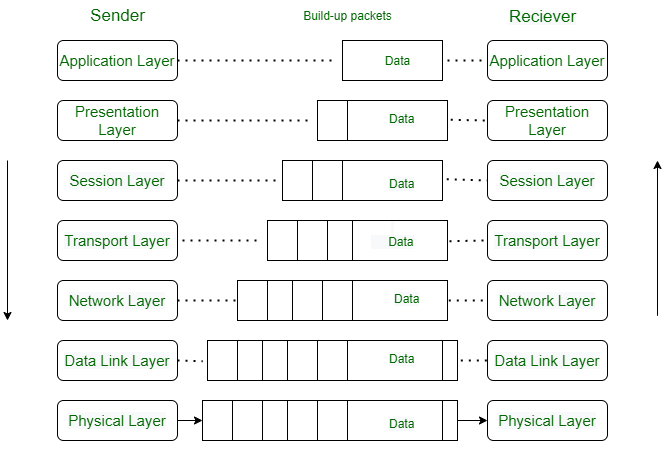How Communication happens using OSI model
Last Updated :
16 Mar, 2021
The Open System Interconnection (OSI) model is a standard “reference model” created by an International Organization for Standardization (ISO) to describe how software and hardware components involved in network communication divide efforts and interact with each other.
The OSI model defines a seven-layer set of functional elements, from physical interrelations at level 1 (physical layer) up to layer 7 (application layer). Transmission Control Protocol (TCP) and Internet Protocol (IP) are two network standards that define the Internet. IP defines how computers can receive data from each other on a mutually connected set of networks. TCP defines how such networks can have more reliable channels of communication.
Need of layers in the OSI model :
- The approach of establishing a link between two devices for communicating and sharing information is complex. Generating profitable communication takes many tasks. A network architecture needs to be developed to perform all these functions.
- In network architecture, various tasks and functions are classified into related and manageable sets called LAYERS. Network architecture can be defined as a set of protocols that describe how each layer functions. Protocols are hidden in the OSI model and are easily changed as technology changes.
- Intermediate systems require only a few layers and not all layers. Protocol layering enables us to design the system or device to which the consecutive layers are placed. It also allows services to be distinct from implementation.

A 7 Layer OSI/ISO reference Model
The reasons and advantages of using network architecture are as follows :
- The layered architecture provides variability to renovate and expand network services.
- Management of new services and network infrastructure has become easier. It removes complications from the design process because the functions and their negotiation of each layer are distinguishable.
- The number of layers, the names, and functions of the layers assigned to them can change from network to network. But for all networks, always the lower layer provides something Services of its upper layer.
- The concept of layered architecture is a new way of looking at networks.
- Logical segmentation allows parallel work on different tasks by different teams simultaneously.
- Due to segmentation (layered structure), it is possible to break complex problems into simple and more feasible tasks.
The communication process in the OSI/ISO model :

An exchange using ISO/OSI Model
- In higher layers, each layer of the sender adds its information to the message received from above that layer and moves the entire package just below the layer as shown in the figure.
- Each layer added its information in the form of headers. Headers are added at the level of the messages (6, 5, 4, 3, and 2). A header is added at the Data Link layer (layer 2).
- At the physical layer, communication is direct i.e. the sender sends a stream of bits to the receiver. At the physical layer (layer 1) the entire package is converted into a form that can be transferred to the receiver. On the receiver side, each process is accompanied layer-by-layer to receive and delete message data.
- Always the upper OSI layers are implemented in the software (Transport layer, Session layer, Presentation layer, Application layer (4, 5,) and the lower layers are a combination of hardware and software (layer 2, 3), except for the physical layer which is mostly hardware. Layer 1, 2, and 3 (ie physical layer, data link layer, and network layer) are network support layers. They deal with physical aspects of moving data such as electrical specifications, physical connections, physical address, and transport time and reliability from one device to another. Layer 4, Transport layer end to end ensures reliable data transmission.
- Not all applications need to use seven layers. The lower three layers are sufficient for most applications. Each layer is made up of electronic circuits and/or software and has a separate existence from the rest of the layers.
- Each layer is assumed to handle messages or data from the layers that are above or below it. This is done by following protocol rules.
- Thus, each layer takes data from the adjacent layer, Handles it according to these rules, and then sends the processed data to the next layer on the other side.
Share your thoughts in the comments
Please Login to comment...